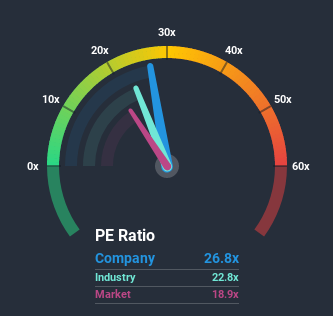What Allied Motion Technologies Inc.'s (NASDAQ:AMOT) P/E Is Not Telling You

When close to half the companies in the United States have price-to-earnings ratios (or "P/E's") below 18x, you may consider Allied Motion Technologies Inc. (NASDAQ:AMOT) as a stock to potentially avoid with its 26.8x P/E ratio. Nonetheless, we'd need to dig a little deeper to determine if there is a rational basis for the elevated P/E.
Allied Motion Technologies has been struggling lately as its earnings have declined faster than most other companies. It might be that many expect the dismal earnings performance to recover substantially, which has kept the P/E from collapsing. If not, then existing shareholders may be very nervous about the viability of the share price.
Check out our latest analysis for Allied Motion Technologies
If you'd like to see what analysts are forecasting going forward, you should check out our free report on Allied Motion Technologies.
Does Growth Match The High P/E?
Allied Motion Technologies' P/E ratio would be typical for a company that's expected to deliver solid growth, and importantly, perform better than the market.
Taking a look back first, the company's earnings per share growth last year wasn't something to get excited about as it posted a disappointing decline of 9.4%. However, a few very strong years before that means that it was still able to grow EPS by an impressive 69% in total over the last three years. Accordingly, while they would have preferred to keep the run going, shareholders would probably welcome the medium-term rates of earnings growth.
Shifting to the future, estimates from the three analysts covering the company suggest earnings growth is heading into negative territory, declining 9.6% over the next year. That's not great when the rest of the market is expected to grow by 3.2%.
With this information, we find it concerning that Allied Motion Technologies is trading at a P/E higher than the market. It seems most investors are hoping for a turnaround in the company's business prospects, but the analyst cohort is not so confident this will happen. Only the boldest would assume these prices are sustainable as these declining earnings are likely to weigh heavily on the share price eventually.
What We Can Learn From Allied Motion Technologies' P/E?
It's argued the price-to-earnings ratio is an inferior measure of value within certain industries, but it can be a powerful business sentiment indicator.
We've established that Allied Motion Technologies currently trades on a much higher than expected P/E for a company whose earnings are forecast to decline. When we see a poor outlook with earnings heading backwards, we suspect the share price is at risk of declining, sending the high P/E lower. This places shareholders' investments at significant risk and potential investors in danger of paying an excessive premium.
And what about other risks? Every company has them, and we've spotted 2 warning signs for Allied Motion Technologies you should know about.
If these risks are making you reconsider your opinion on Allied Motion Technologies, explore our interactive list of high quality stocks to get an idea of what else is out there.
This article by Simply Wall St is general in nature. It does not constitute a recommendation to buy or sell any stock, and does not take account of your objectives, or your financial situation. We aim to bring you long-term focused analysis driven by fundamental data. Note that our analysis may not factor in the latest price-sensitive company announcements or qualitative material. Simply Wall St has no position in any stocks mentioned.
Have feedback on this article? Concerned about the content? Get in touch with us directly. Alternatively, email editorial-team@simplywallst.com.



